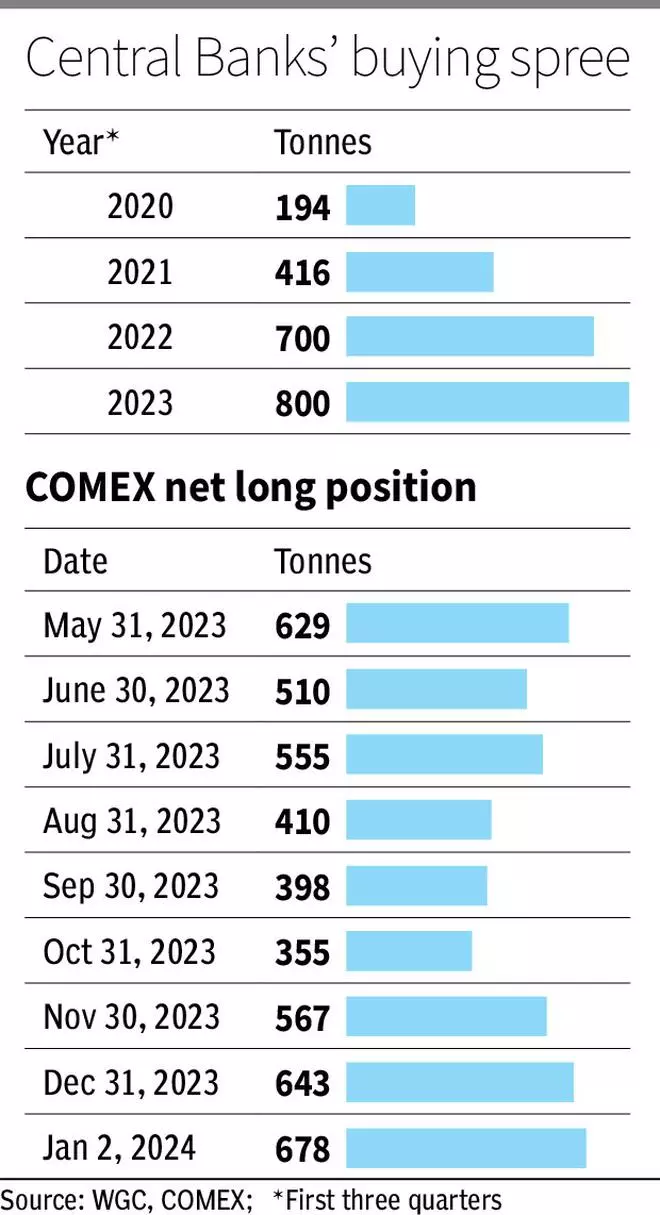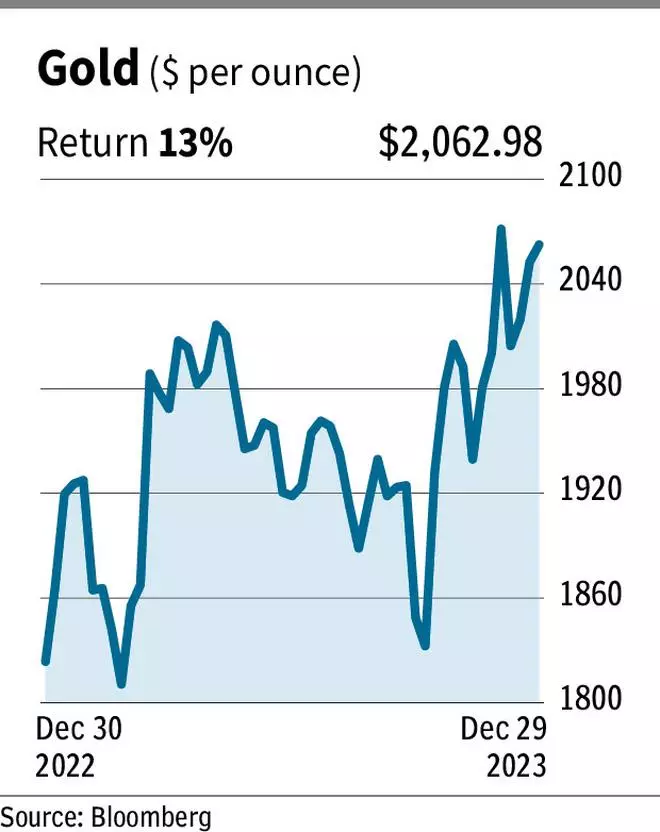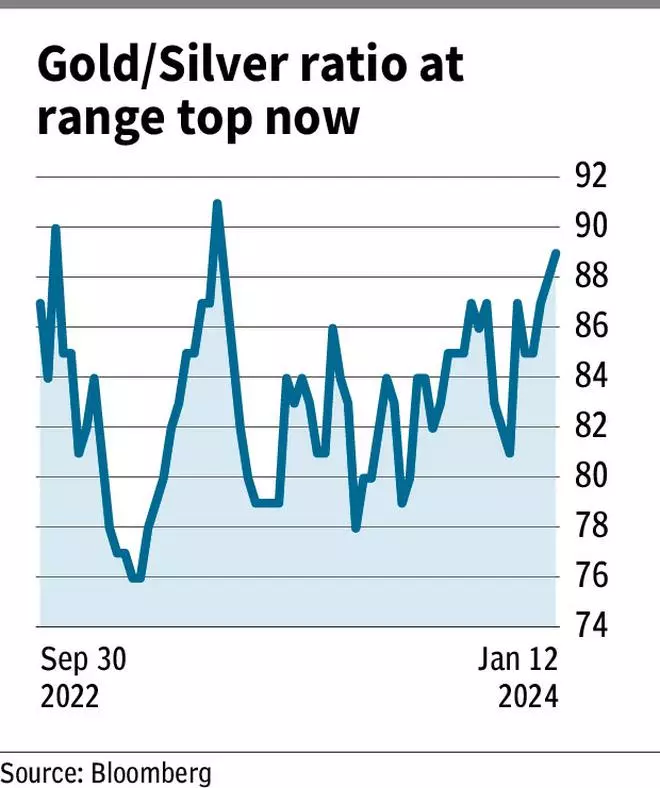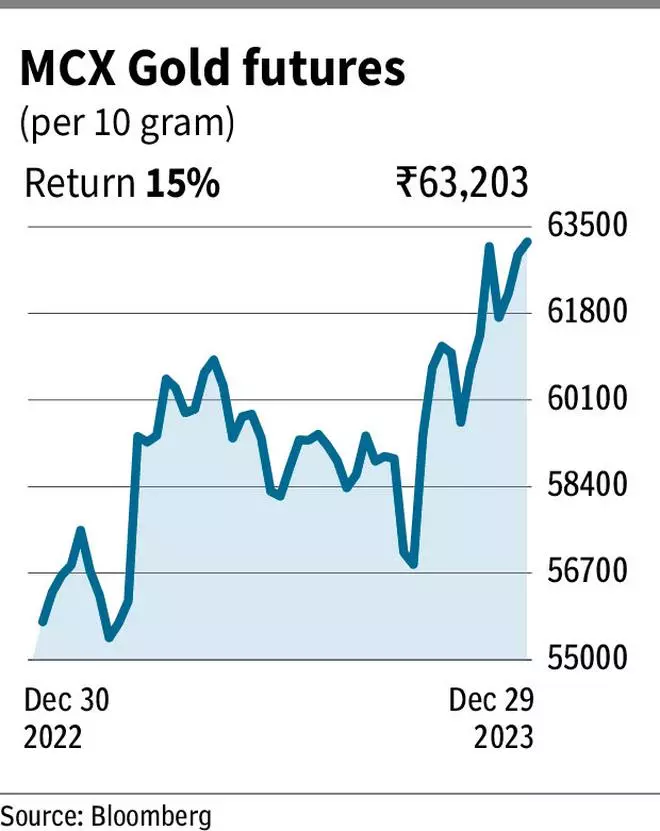All that glitters is really gold, this time around!
Gold had a strong showing in 2023. Both in terms of dollar and rupee, the precious metal appreciated.
In terms of dollar, gold gained 13 per cent as it ended the year at $2,063 per ounce. In the domestic market, gold futures on the Multi Commodity Exchange (MCX) wrapped up the year at ₹63,203 per 10 grams, appreciating 15 per cent.
Notably, in terms of rupee, gold futures produced a double-digit gain in four of the last five years, establishing its potential as good diversification bet in one’s portfolio
In our outlook for 2023, we forecast gold to touch $2,100 and ₹61,000 in global and local markets, respectively. The respective highs for the year were $2,136 and ₹63,881, which were made in December.
Here, we look at the factors that moved gold in 2023 and what is in store in 2024.
Crises-powered rally
The common wisdom is that gold does well during crises and this theory remained true in 2023. The risk-on sentiment prevailed in the market last year, which can be seen from the rally in the equity markets. But despite this, gold prices went up, mainly sparked off by two events, which led to investors seeking safety in gold.
In March 2023, the Silicon Valley Bank crisis and in October, the Israel-Hamas war called on gold bulls. But between May and September, the prices moderated, almost erasing the gains that resulted from the March rally. Overall, the latest stretch of the upside since October resulted in gold posting a gain for the year.
On the demand front, central banks across the globe continued to add gold to their reserves. According to World Gold Council (WGC) data, central banks bought about 800 tonnes of the yellow metal in the first three quarters of 2023 as against 700 tonnes in the corresponding period of the previous year.
Towards the end of last year, speculators contributed significantly. The net long position on gold futures on the COMEX has been steadily increasing over the past few months. It stood at 678 tonnes on January 2, 2024, the highest since April 2023.

Key factors for 2024
All eyes are on the Fed. The latest economic projections released in December hint that the Fed is likely to cut rates three times, 25 basis points each, in 2024. A rate cut in the US can drive the treasury yields and the dollar down.
A fall in bond yields reduces the opportunity cost. Because, when bond yields are high, it means investors can seek safety in addition to the interest income and vice-versa. So, a decline in yields on bonds makes gold, another safe haven, more attractive.
Softening US yields can result in dollar depreciation, which can lead to a rally in commodities. These factors are likely to give upward pressure on gold prices.
Another favourable factor for gold could be the slowdown in economic growth. The Fed forecasts the real GDP growth in the US to drop to 1.4 per cent in 2024 versus 2.6 per cent in 2023. Similarly, China, the biggest consumer of gold, is likely to see its growth slowing to 4.2 per cent in 2024 as against 5 per cent in 2023, as per the World Economic Outlook by the International Monetary Fund (IMF). Yet, India, the second largest consumer for gold, remains a bright spot.
Broadly, a slowdown in global growth could push investors to look for safety. Notably, according to a section of economists and analysts, the recession is not off the table yet. Should the economy face a recession, it can boost gold prices. Thus, if inflation runs too hot (stronger than expected economy) or falls much more than expected due to recession — both are positive for Gold. On the other hand, a ‘soft landing’ in the US will boost the risk-on sentiment and this remains the biggest risk for gold prices.
Besides, the geopolitics is not stable. The Ukraine war and the Israel-Hamas conflict are persistent risks to the market and the economy. While the risk premia of these events appear to have softened, any escalation is likely to trigger a safe haven rally in gold. China-Taiwan tensions are also a tail risk in geopolitics. Simmering geopolitical tensions can provide floor to downside in gold prices
Apart from this, the US and India are facing elections, and this could lead to demand for gold as a hedge against unforeseen results.
While the above are potential factors that can push gold price up, should there be not much deviations from the broader current market expectations of soft landing and no geopolitical escalations, there are chances for participants to book profits in gold, which can lead to some correction in prices.
Overall, the downside in gold price appears limited. How far the prices can go up depends on how the events pan out, which at the moment, is highly uncertain. After all, the Fed itself has hinted that rate cuts are more likely to come but the path remains uncertain.
Nevertheless, investors can look to park some of their savings in gold to maintain a well-balanced portfolio. Any of the options — Gold ETFs, Sovereign Gold Bonds or direct buying — can be considered to invest in gold with a long-term perspective.

Gold-Silver ratio
Gold-Silver ratio shows the relative performance of gold and silver against each other. It is arrived by dividing the price of gold by the price of silver. Hence, when gold outperforms silver, the ratio will go up and vice-versa. Since October 2022, the ratio has largely been staying sideways, between 75 and 90, because the returns of gold and silver were largely the same. The point-to-point return of gold and silver since October 2022 is 24 and 20 per cent, respectively.
Currently, at 89, the ratio is near the upper limit of the range. So, this ratio suggests that silver is likely to outperform gold from here. Hence, investors can give more weight to silver, for the short term, within the precious metal investment. But do note, this ratio in no way indicates that gold prices are likely to fall. Just that silver could outperform the yellow metal in the short term.

Technical analysis
Gold’s long-term bull trend is intact. But now, it is hovering around a psychologically important level of $2,080. This is a potential barrier because the price has fallen off this level thrice in the past — August 2020, March 2022 and May 2023. So, on the back of this resistance, there could be a drop in price.
However, a fall below the price range of $1,900 and $1,950 is less likely as this is a considerable demand zone. So, the two possible price trajectories are as follows. One, the price moderates to the above-mentioned price band and then resumes the rally. Such a rally can lift the gold price to $2,200. Two, if gold breaks out of $2,080 without a dip in price, the price could touch $2,300 at least once before the end of this year.
In the domestic market, the uptrend is even more prominent because of the depreciation of rupee versus the dollar. Gold futures on the MCX hit a record high of ₹64,460 before softening to the current level of ₹62,362.
MCX gold futures is forecast to continue the rally and likely to hit ₹68,000 in 2024 if there is a correction from the current level. Such a decline in price is expected to be restricted to the price of ₹58,000-60,000. This is a strong support against which gold futures is likely to resume the upswing.

Alternatively, a breakout of $2,080 in dollar terms straight away can push MCX gold futures above ₹68,000. In such a case, the rally can lift the price to the region between ₹70,000 and ₹72,000.



